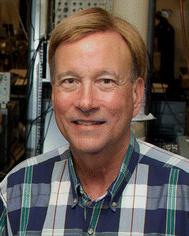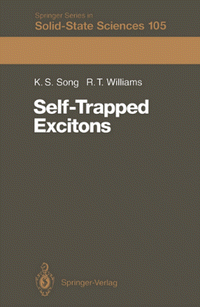Introduction to the themed collections in memoriam of Prof. Richard T. Williams (May 27, 1946–July 5, 2021)
Oana D.
Jurchescu
 *a,
Weronika
Wolszczak
*a,
Weronika
Wolszczak
 b,
Arnold
Burger
b,
Arnold
Burger
 c,
Edith
Bourret-Courchesne
c,
Edith
Bourret-Courchesne
 b and
Pieter
Dorenbos
b and
Pieter
Dorenbos
 d
d
aDepartment of Physics and Center for Functional Materials, Wake Forest University, USA. E-mail: jurchescu@wfu.edu
bMaterials Sciences Division, Lawrence Berkeley National Laboratory, USA
cDepartment of Life and Physical Sciences, Fisk University, USA
dFaculty of Applied Sciences, Department of Radiation Science and Technology, Delft University of Technology, The Netherlands
Abstract
This themed collection published across the Journal of Materials Chemistry C and Materials Advances commemorates Richard T. Williams, Reynolds Professor of Physics at Wake Forest University (WFU), who passed away on July 5, 2021, at the age of 75.
Prof. Williams earned a BS in Physics at Wake Forest University (WFU) in 1968 and then earned an MA in 1971 and PhD in Physics in 1974 at Princeton University. After a successful career at the Naval Research Laboratory, he joined WFU, where he also helped establish the Physics PhD program and in the 1980s and he mentored the first physics PhD graduate. He supervised 19 PhD theses, co-authored more than 250 scientific articles and his book on “Self-Trapped Excitons” (1993) remains a prime record of essential fundamental work. Richard was internationally renowned for his pioneering contributions to the science of scintillators and ultrafast laser spectroscopy. His work has impacted many technological applications from energy and environment to national security and healthcare.
Throughout his career Prof. Williams showed a keen interest in excitonic processes in the solid state. His interest covered the ionisation processes leading to free charge carrier creation, charge carrier migration through the valence and conduction bands which is then followed by recombination at luminescence centers or intrinsic defects. These processes determine the operation of scintillating materials for the detection of ionizing radiation.
Prof. Williams’ research group operated an ultrafast laser laboratory configured to perform measurements simulating specific conditions encountered in scintillation tracks and determining rate and transport properties that govern the physics of scintillation. His group also conducted computational modeling of scintillation tracks and recombination physics in order to connect the spatial structures and geometries in which the optical measurements were made with the highly inhomogeneous spatial structure of electron tracks in scintillators. Interband z-scan for nonlinear quenching rates and confocal 2-photon measurements of charge separation, charge collection, and light emission in semiconducting and insulating scintillators were developed in his group along with extensive use of picosecond optical absorption spectroscopy and streak camera fluorescence to characterize scintillation materials. These contributions are important for better understanding of the scintillation mechanisms but equally well of interest to other fields like photocatalysis and photovoltaics.
Scintillation materials research started already as early as Röntgen’s discovery of X-rays and Rutherford’s discovery of alpha particles. Today, more than 120 years later, it remains an ever-active field of science. New technologies, new applications, and new understanding are the drivers of today’s research in the scintillator field. Positron Emission Tomography (PET) scanners for medical diagnostics contain up to 100![[thin space (1/6-em)]](https://www.rsc.org/images/entities/char_2009.gif) 000 scintillating crystals. There is a drive for developing ultra-high time resolution scintillators to enable Time of Flight (TOF)-PET-scanners. The same applies for high energy physics where, after the discovery of the Higgs boson, new machines are on the drawing table requiring new ultra-fast scintillators. A number of schemes for preventive or forensic detection of nuclear radiation – gamma, neutron, neutrino – require tailoring the properties of scintillators. The past decade has witnessed a surge of research on Pb-based perovskite halides because they form a superior class of materials to convert solar energy into electric energy in photovoltaic cells. The same family of materials show ultrafast scintillation phenomena.
000 scintillating crystals. There is a drive for developing ultra-high time resolution scintillators to enable Time of Flight (TOF)-PET-scanners. The same applies for high energy physics where, after the discovery of the Higgs boson, new machines are on the drawing table requiring new ultra-fast scintillators. A number of schemes for preventive or forensic detection of nuclear radiation – gamma, neutron, neutrino – require tailoring the properties of scintillators. The past decade has witnessed a surge of research on Pb-based perovskite halides because they form a superior class of materials to convert solar energy into electric energy in photovoltaic cells. The same family of materials show ultrafast scintillation phenomena.
This themed collection of papers in memoriam of Prof. Richard T. Williams covers the topics and fields where he had impact during his exceptional career: it contains several contributions on novel Pb-based perovskite halides and derivatives thereof, i.e., Cs4PbBr6, (PEA)2PbBr4, Cs4PbBi2(Br,I)12, (BA)2XBr4 (X = Pb, Cu, Sn), CsPbBr3. Other contributions relate to engineering of traditional scintillators like CsI, the garnet family of compounds, and PbWO4 towards a better performance in terms of energy resolution or high-count rate applications. In addition, there are contributions on fundamental processes in organic scintillators, on CdSe nanoplatelets, scintillating thin films, and a contribution on photocatalysis. All contributions connect closely to the interests of Prof. Richard T. Williams and his contributions to science. Richard’s colleagues, students and friends will forever remember his passion for science, his kindness, his generous mentoring spirit, his love of teaching, and his humour.
| This journal is © The Royal Society of Chemistry 2022 |


